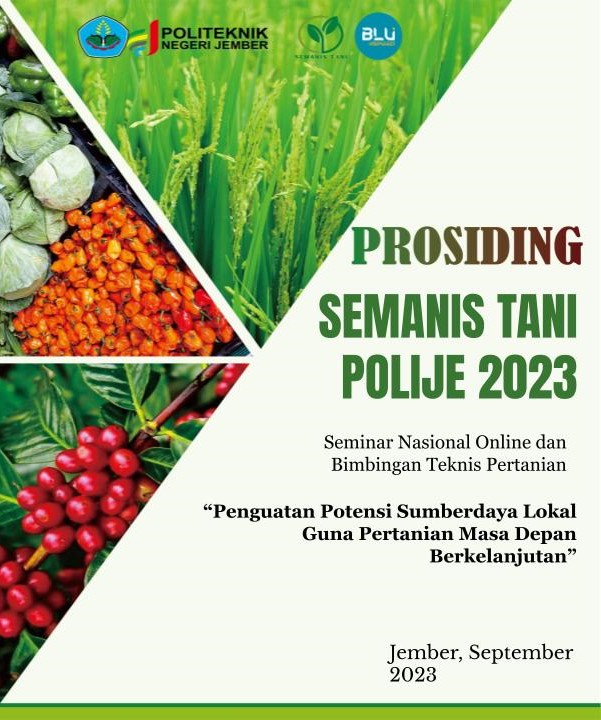Profil Iklim Mikro pada Budidaya Tanaman Kopi Robusta di Politeknik Negeri Jember
DOI:
https://doi.org/10.25047/agropross.2023.485Kata Kunci:
Microclimat, Open Field, Robusta CoffeeAbstrak
Plant microclimate is the condition around plant from roots up to the top of canopy or up to 2 meters above the object. Microclimate is influenced by solar energy that received by the atmosphere, soil surface, and physical environment that exists on the land surface. The purpose of this study was to determine profile of microclimate in coffee cultivation that compared to open land in Jember State Polytechnic. The research was conducted on 03-05 March 2023. Observations included soil temperature, air temperature, and air humidity which were carried out at 3 times; in the morning (07.00-08.00), afternoon (12.00-13.00), and evening (17.00-18.00). The results showed that the soil temperature in coffee plantations had temperatures of 27.6 oC, 29.2 oC, and 26.9 oC, while in open land had temperatures 29 oC, 33.7 oC, and 28.7 oC. Analysis the air temperature was consecutive 29.2 oC, 34.5 oC, and 26.7 oC while in the open field, the air temperature was 30.2 oC, 39.7 oC, and 27.6 oC. Air humidity values in Robusta coffee plantations were 78.8%, 51,3%, and 90.1% respectively, while in open land 75,5%, 87.5%, and 99%. Thus it can be concluded that the soil and air temperature of two fields have a trend increasing temperature during the day and decreasing in the afternoon, while the humidity in has decreased during the day and rises again in the afternoon, in contrast to observations of air humidity in open land the tren increase from morning to evening
Unduhan
Referensi
Arda, G., & Kencana, P. K. D. (2015). Pemodelan konsentrasi gas pada pengemasan tertutup jamur tiram (Pleurotus ostreatus) segar. Jurnal Agrotekno, 7(2), 30–34.
Azmi, E. N. (2019). Dinamika Temperatur Dan Kelembaban Tanah Serta Dampaknya Terhadap Pertumbuhan Dan Produksi Tanaman Kopi Dalam Sistem Agroforestri (Universitas Brawijaya). Retrieved from http://repository.ub.ac.id/id/eprint/172977
Badan Meteorologi Klimatologi dan Geofisika. (2022). Buku Saku Klimatologi: Iklim dan Cuaca Kita. Jakarta.
Evizal, R., Sugiatno, & Prasmawati, F. E. (2015). Ragam Kultivar Kopi di Lampung. Agrotrop: Journal on Agriculture Science, 5(1), 80–88.
Karyati, Putri, R. O., & Syafrudin, M. (2018). Soil Temperature and Humidity at Post Mining Revegetation in PT Adimitra Baratama Nusantara, East Kalimantan Province. Agrifor, 17(1), 103–114.
Kementrian Luar Negeri Repulik Indonesia. (2018). Kopi Indonesia. Retrieved from https://kemlu.go.id/chicago/id/read/kopi-indonesia/4484/etc-menu
Peraturan Menteri Pertanian. Peraturan Menteri Pertanian Republik Indonesia Nomor 49/Permentan/OT.140/4/2014 Tentang Pedoman Teknis Budidaya Kopi yang Baik (good agriculture practices /gap on coffee). , Sekretariat Negara Republik Indonesia § (2014).
Purba, L. I., Asri, Armus, R., Amartani, S. R. F. P. K., Yasa, I. W., Saidah, H., & Setyawan, M. B. (2021). AGROKLIMATOLOGI.
Rahayu, D., Rahayu, W,P., Lioe, N., Herawati, D., Broto, W., dan Ambarwati, S. (2015). PENGARUH SUHU DAN KELEMBABAN TERHADAP PERTUMBUHAN Fusarium. Agritech, 35(2), 156–163.
Statistik, B. P. (2021). STATISTIK KOPI 2020. Retrieved from https://www.bps.go.id/publication/download.html?nrbvfeve=YjFiNmNmMmE2YWFkMWVlMmQ4YTRjNjU2&xzmn=aHR0cHM6Ly93d3cuYnBzLmdvLmlkL3B1YmxpY2F0aW9uLzIwMjEvMTEvMzAvYjFiNmNmMmE2YWFkMWVlMmQ4YTRjNjU2L3N0YXRpc3Rpay1rb3BpLWluZG9uZXNpYS0yMDIwLmh0bWw%3D&twoadfnoarfeauf=M
Statistik, B. P. (2022). STATISTIK KOPI INDONESIA 2021. Retrieved from https://www.bps.go.id/publication/download.html?nrbvfeve=YmI5NjVlZWYzYjNjN2JiYjhlNzBlOWRl&xzmn=aHR0cHM6Ly93d3cuYnBzLmdvLmlkL3B1YmxpY2F0aW9uLzIwMjIvMTEvMzAvYmI5NjVlZWYzYjNjN2JiYjhlNzBlOWRlL3N0YXRpc3Rpay1rb3BpLWluZG9uZXNpYS0yMDIxLmh0bWw%3D&twoadfnoarfeauf=M
Sudaryono. (2004). Pengaruh Naungan Terhadap Perubahan Iklim Mikro Pada Budidaya Tanaman Tembakau Rakyat. Jurnal Teknologi Lingkungan, 5(1), 56–62.
Wilujeng, E. D. I., Widyastuti, R., & Tjahjono, B. (2020). Keanekaragaman Collembola pada Lahan Terdampak Material Piroklastik Gunungapi Kelud di Kecamatan Ngantang, Malang (IPB UNIVERSITY). Retrieved from http://repository.ipb.ac.id/handle/123456789/102914
Unduhan
Diterbitkan
Cara Mengutip
Terbitan
Bagian
Lisensi
Hak Cipta (c) 2023 Elly Daru Ika Wilujeng, Rindha Rentina Darah Pertami, Sinta Dwi Rahma, Sinta Dwi Rahma, Ahmad Fahim Firmansyah

Artikel ini berlisensi Creative Commons Attribution 4.0 International License.
Hak cipta (Copyright) artikel yang dipublikasikan di Agropross : National Conference Proceedings of Agriculture dipegang oleh penulis (Copyright by Authors) di bawah Creative Commons Attribution 4.0 International License (CC-BY). Sehingga penulis tidak memerlukan perjanjian pengalihan hak cipta yang harus diserahkan kepada redaksi.






